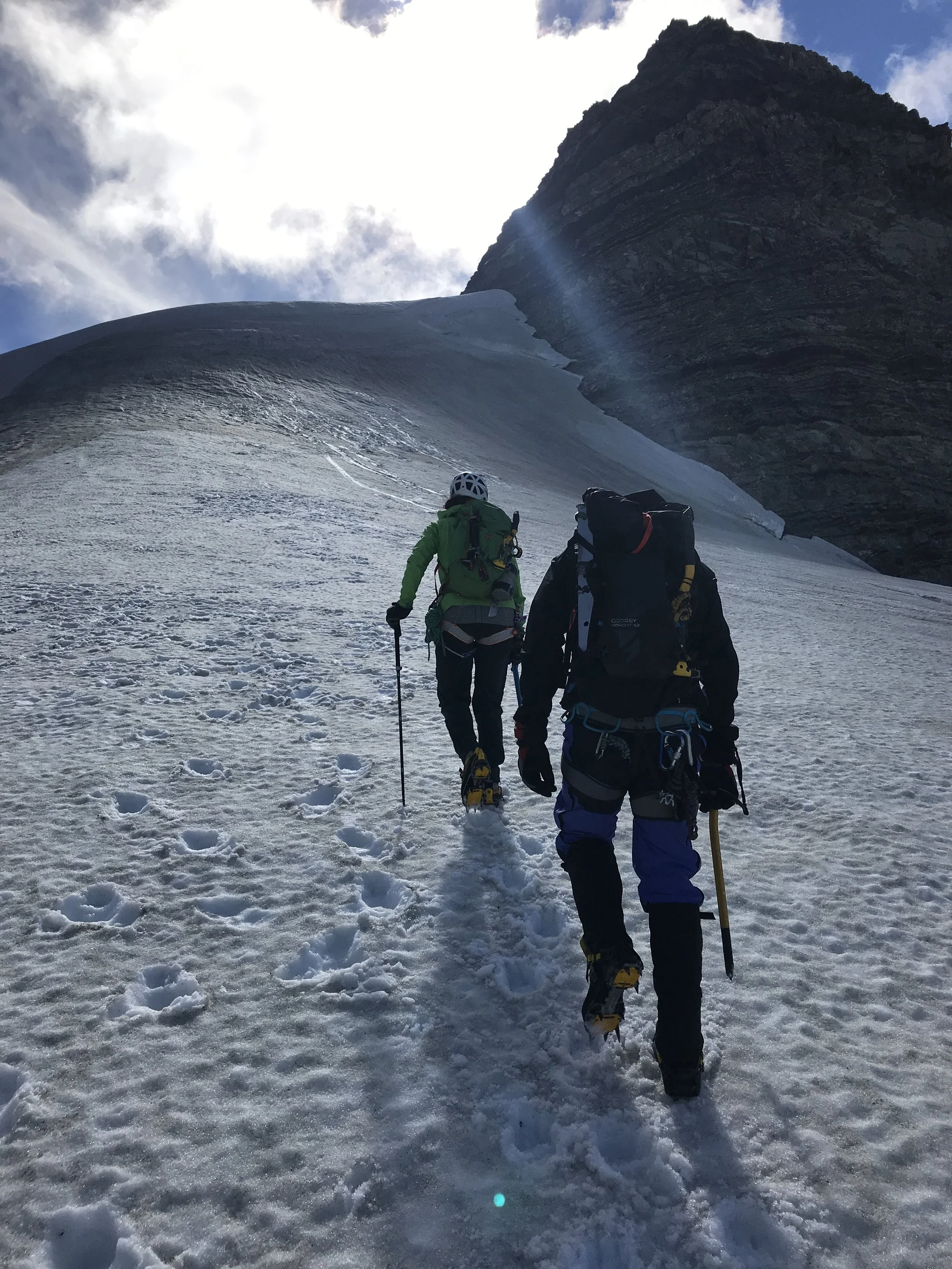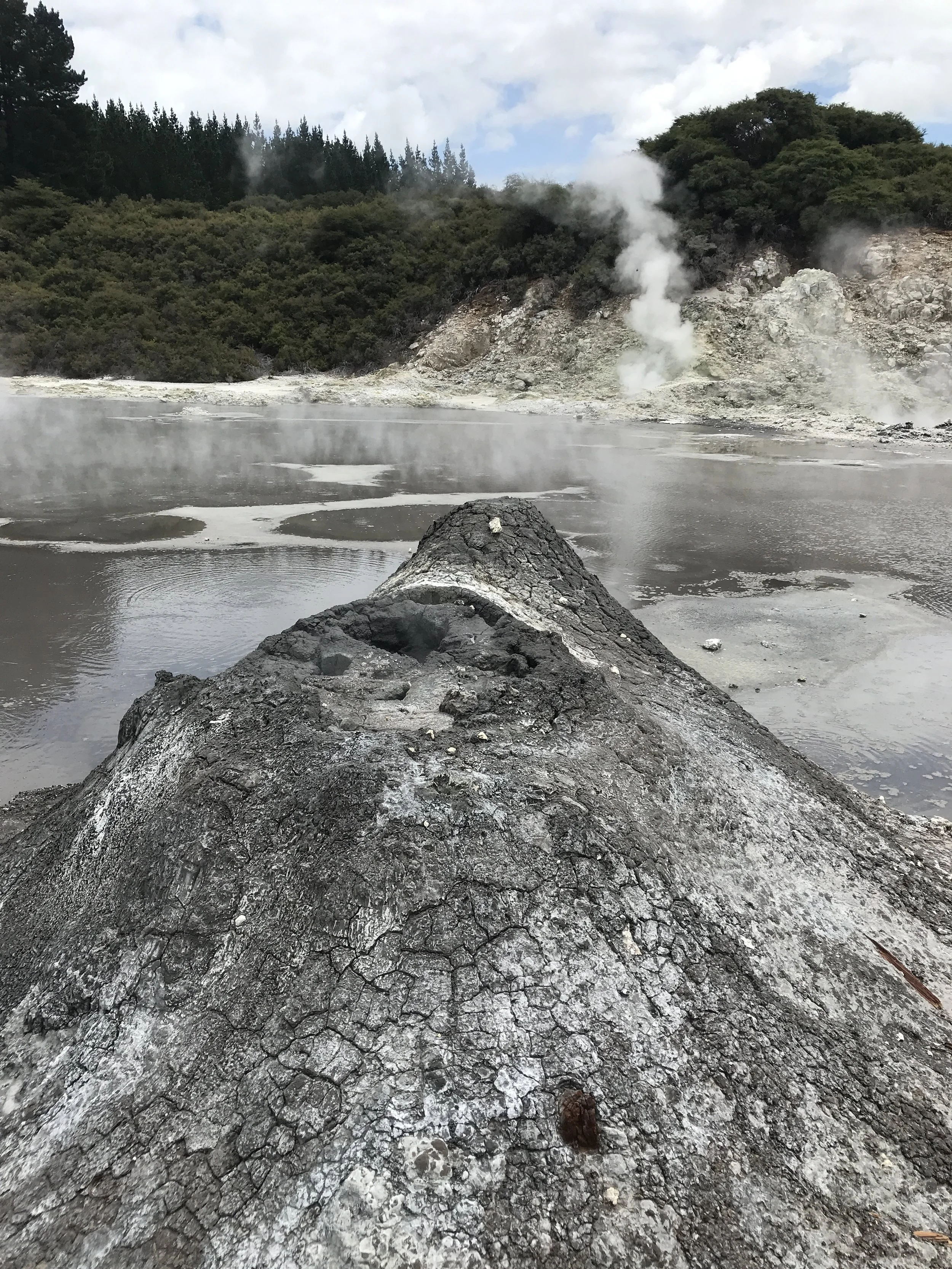The Fawlty Towers of Rock Climbing
“Are you ok, dear?” The British woman looks up just after she’s dodged the falling clump of trad equipment that has hit the ground. Her husband is stuck half-way through leading a climb on Hanging Rock, a series of rock climbs on a farm in Canterbury. We’re learning trad climbing - climbing rocks while placing your own protection (nuts, cams and hexes). That’s what mountaineers have to do when going over technical sections of a mountain climb but in their case they’re not just placing rock protection, they may also be placing ice protection like ice screws. Our guide, Elke, has brought us to Hanging Rock since the winds and rain have chased us from Mt Cook but the East Coast of New Zealand is still dry and suitable for climbing.
Elke with her trad climbing rack at Hanging Rock, Timaru
Brent learning to trad climb on Hanging Rock, Timaru
The characters that share the crag with us are quite unusual and according to Elke, not your typical “dirtbags” - a moniker for rock climbers who spends all their time climbing and none of their time holding a steady job. Although that currently would apply to Brent and I (with the slight distinction of living out of Brent’s mom’s house and not out of a car), we fail the dirtbag test in several important ways - “dirtbags” use the cheapest equipment of dubious quality and reliability because they can’t afford much else, and they usually climb a few grades harder than what Brent and I can currently muster. Anyway, on that bright day in New Zealand, none of our crag companions are official dirtbags.
There is a Kiwi family with two kids where the mom is obviously the designated belayer and the dad the main climber. The kids, a boy and a girl, don’t seem to be in too much of a rush to get on the rope. Once they do, it becomes clear why. From around the corner we can hear the mom and dad berating the boy: “Put your hands on the rock, not on the rope! put your hands on the rock I said!” The saving grace is that boy seems to be stuck in exactly the same spot that his dad will get stuck on the next climb. Serves him right!
There’s a young couple from England who got lost on the way to the crag. Their gear bag is the most impressive thing I’ve seen - it lands on the ground with a serious thud and out emerge clusters of dozens of nuts, hexes and the biggest cam I’ve ever seen - that thing is the size of a dinner plate! By comparison, our guide’s largest cam seems several times smaller. Just as the monster cam appears, Elke is half way up our climb and not finding many spots to place protection. She calls out: “There’s only a huge crack but it needs the biggest cam”. I look over to the British guy, whose face lights up with a smile: “Aha!!!” he says in self-satisfied way as he pulls out monster cam. His wife turns to me and explains with a smile: “That’s his Christmas present. He takes it on every climb”. I watch the couple climb - they are quite good and alternate leading the route. Because of the cam’s massive size, they seem to place it as one of the first pieces of protection, mainly so it doesn’t get in the way of the climb later.
The funniest couple at the crag that day are the older British couple. They remind me of a rock climbing version of Basil and Sybil of the Fawlty Towers. Hearing their loud voices and strong British accents sound identical to the TV duo. Everyone else is trying hard not to laugh too loud. The husband is lanky and quite clutzy - he dropped his gear bundle at least once and then on a rappel, he dropped another piece of equipment. I saw it hit the ground as his wife ducked out of the way - her helmet seemed to be less protection against falling rocks and more protection against random objects her husband was bound to drop. Unlike the husband, the wife was short and round, almost the shape of a ball. She was very friendly and chatty and seemed to constantly fuss over her husband and the safety of their climbs. She insisted that they anchor themselves to some roots at the bottom of the rock since they were very close to a cliff. The best part was the wife’s “running commentary” - “oh, I don’t know if I can climb this, I might have to go down”, “dear, I don’t know if I can take that hex out, I gave it a good shove and it’s not moving”, or my favorite: “oh dear, this step is too big for a small person like me”.
Brent likes this climb better than the climbs we did on the rock at Sebastopol Bluffs and definitely more than the climbs we did in Queenstown. The rock is basalt and more bulky with huge boulders that lend themselves very well to Brent’s preferred climbing style - big steps and large swings of the arms. As someone with a +2 ape index. Brent has an advantage of reaching more holds and likes to take advantage of that. By contrast, I’m ape neutral, slightly negative and also shorter than Brent, so I prefer climbs with smaller steps and more delicate balance work - like the Otago Schist in Queenstown and even the rock at Sebastopol bluffs.
Here's what our experience looked like the first time we did multi-pitch rock climbing with Elke in Sebastopol Bluffs in Aoraki / Mt Cook National Park:
We are having a ton of fun as we’re learning how to trad climb and set anchors, as well as follow the lead climber (Elke, our guide). Our new friends, the young British couple, even lend us monster cam so we can practice placing it into the giant crack at the top of one of our climbs. I’m surprised at how much it “walks”, i.e. moves around, after being placed, so it requires some thinking and experimenting before moving up with the climb.
The best part of the day comes at the end. We set up a crevasse rescue simulation at the top of the cliffs. I go first - Elke sets up a tarp at the lip of the cliff for the ropes to go over. She secures me with a safety rope and after Brent and I rope up for glacier travel, I’m lowered over the cliff. I sit quietly in my harness, taking in the views and chatting to the young Britons who were still climbing. Brent managed to haul me out in about 10 minutes. When it was my turn and Brent was lowered, Elke gradually transferred his weight onto me. The next steps were to get his weight onto the anchor safely and then set up a pulley system to pull him up. Even after building a 6:1 system, my arms still hurt from trying to haul Brent up inch by inch. But I did appreciate the exercise - there’s something special having your life hanging on a rope in the hands of your partner and trusting them completely to get you out safely.
Tiger - the mascot of the trusty Land Cruiser of Alpine Recreation









